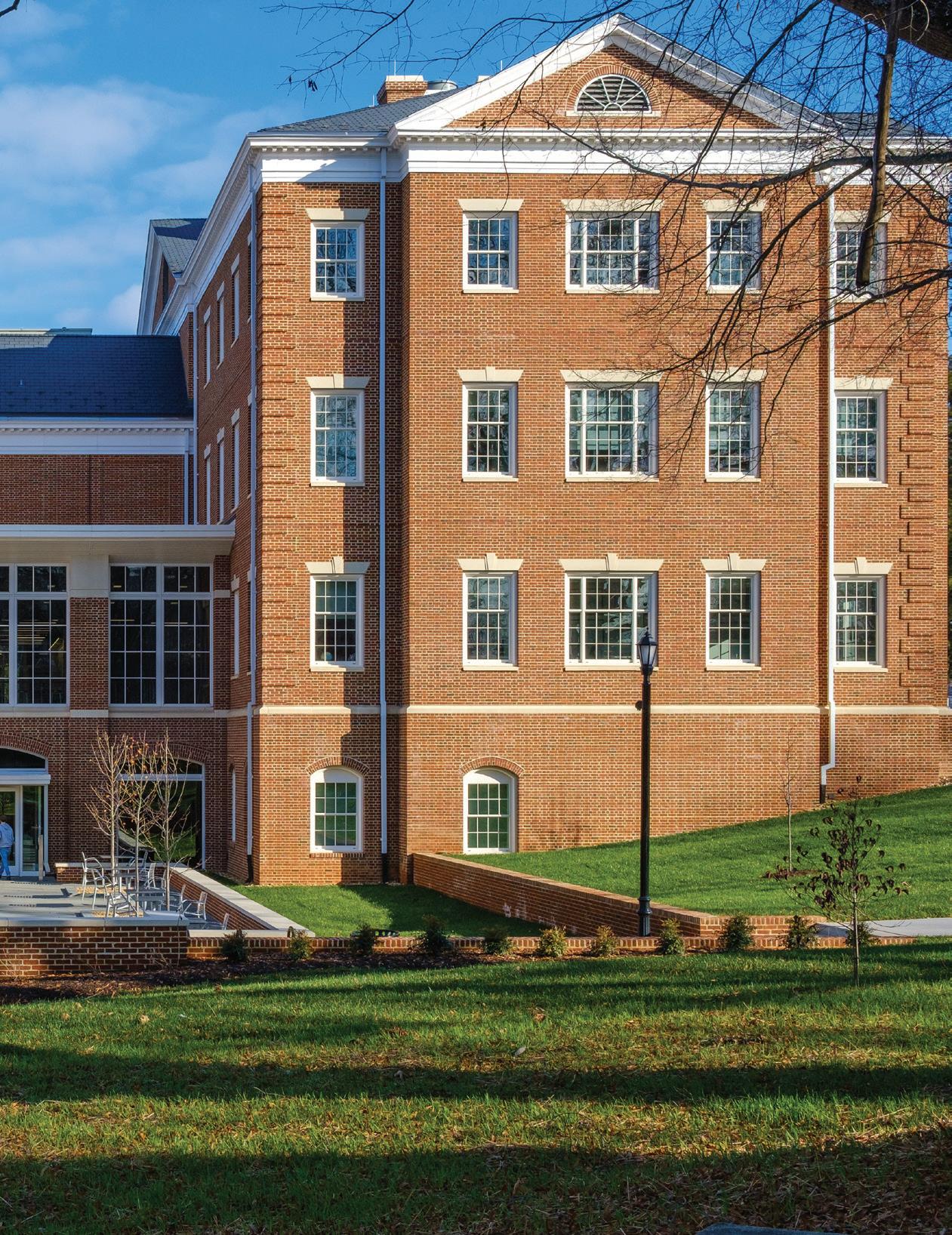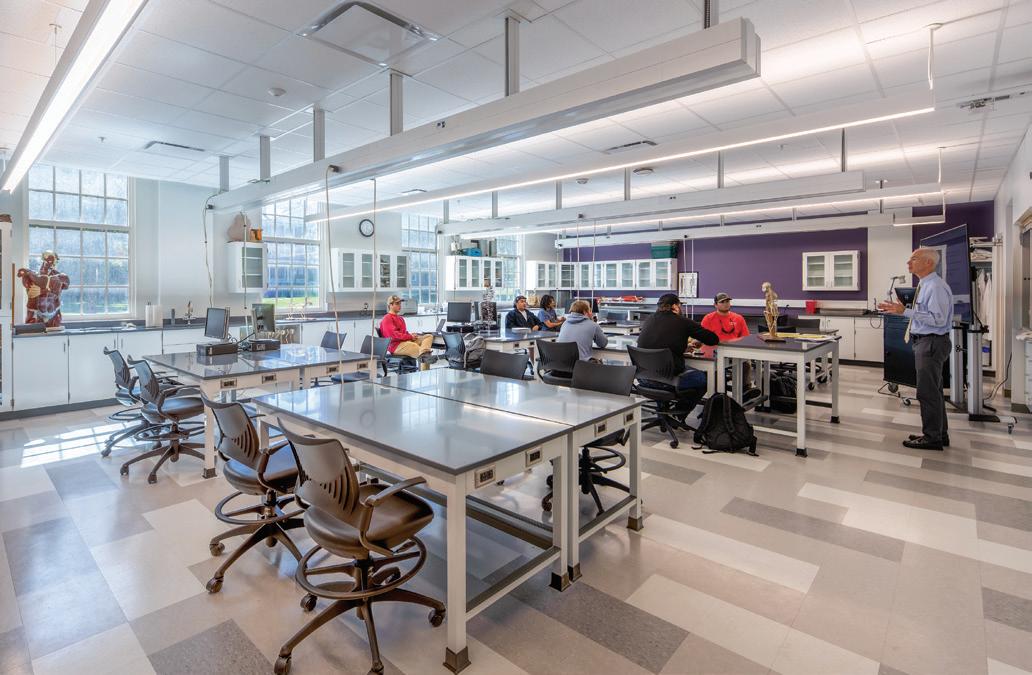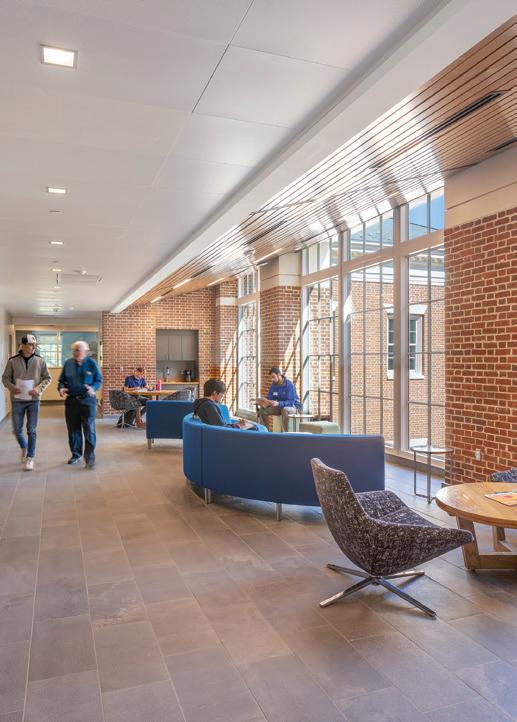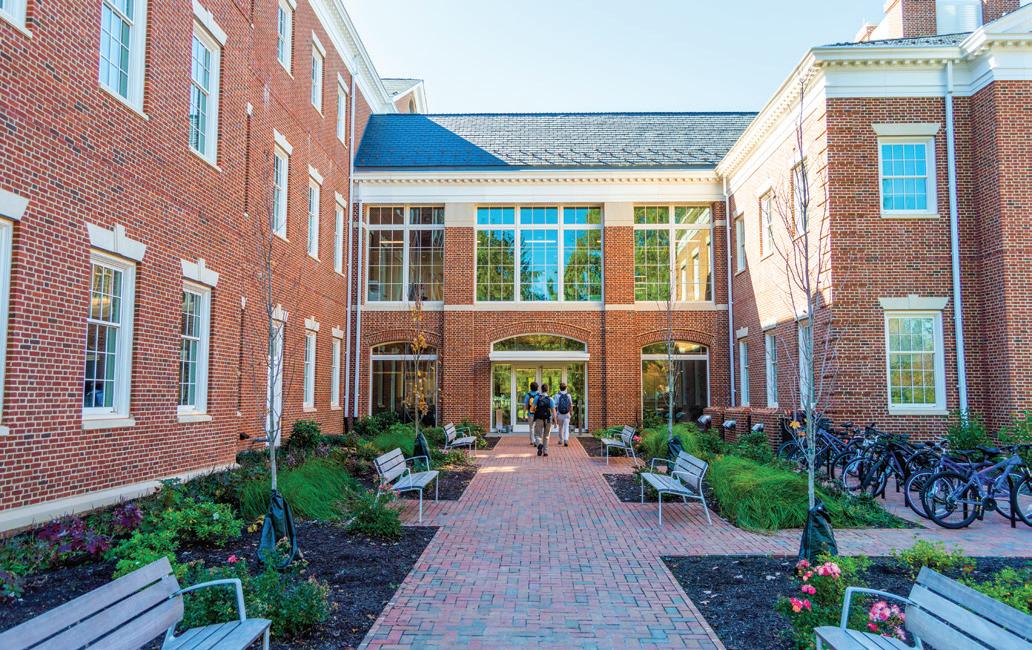
4 minute read
A Temple of Learning
BY ALEXANDRA EVANS
Situated across from the entrance to Johns Auditorium is a patio, which ushers visitors to a pair of glass doors set into the facade of a red brick building. Pushing through the entryway into a twostory atrium, the traditional Federal-style architecture of the exterior gives way to a modern aesthetic of exposed garnet brick and steely grey accents. The sixth home of the sciences at Hampden-Sydney, the Pauley Science Center welcomed its first students to class on August 22, 2022.
The Pauley Science Center was made possible by an extraordinary $30 million gift in 2019 from former College Trustee Stanley F. Pauley. A champion of the sciences, the late Mr. Pauley esteemed Hampden-Sydney as “an institution that is making a real difference, a college that represents the best of American higher education.”
The design of the 73,000-square-foot space is tailored to the unique methods that Hampden-Sydney faculty use to teach science. Kevin Kattwinkel of Hanbury Architects notes that “upper-year classes for science majors at H-SC include research projects that are on par with what we typically see at the graduate level at other colleges and universities. To reflect that emphasis, we adopted the term immersive environments to refer to the research labs that are used to teach those upper-level courses. The building also includes a multi-purpose space suited for in-person presentation and display of the project posters that students produce describing their research.”
Thanks to this exquisite attention to detail and thoughtfulness of planning, the state-of-the-art facility is exceptionally equipped to further bolster the sterling reputation of Hampden-Sydney’s science departments. A reputation that includes such achievements as seven Goldwater Scholars—the nation’s highest undergraduate achievement in natural sciences, math, and engineering.
On either side of the airy, light-infused atrium are two stairwells—one outfitted with a macro view of the galaxy and the other a micro look into molecules. Up on the second floor, a lofted common area houses one of those multi-purpose spaces for presentations and provides an ideal vantage point of the patio outside where the patinaed cupola which once capped Bagby Hall, the fourth home of the sciences at Hampden-Sydney, is prominently displayed.
This iconic memento pays homage to Dr. John Hampden Chamberlayne Bagby, another champion of scientific study at Hampden-Sydney, who “did much to mold the policy of the College and to promote its material welfare and its scholastic standing.” Bagby Hall was the first building devoted entirely to the sciences and housed the department until the erection of Gilmer Hall.
Though the Pauley Science Center has brought the quality of facilities to par with the College’s rigorous standards of scientific study, it is indeed a continuation of the College’s commitment to scientific inquiry and instruction that began at the very founding of our prestigious institution. As Patterson Professor of Biology
Alex Werth noted in his remarks at the November 11, 2022, dedication ceremony, the first purchase that founding president Samuel Stanhope Smith made on behalf of the young College was “philosophical apparatus,” or science equipment in modern parlance. Dr. Werth went on to say that the College’s founders such as James Madison and Patrick Henry “believed very strongly that all citizens should not only understand science but should have experience doing science,” for as James Madison espoused, ‘The advancement of science and diffusion of knowledge is the only guardian of true liberty.’ This is now that place, where all students learn by doing. This building is a temple of learning.”
And it is the entire student body, especially the nonscience majors, with whom the faculty is most eager to share Pauley. “Our science majors deserved better facilities,” Dr. Werth says. “But they already love science, so they would be happy to work in a dusty attic or dank basement. It is our business and government majors, our history and English majors, who will benefit most of all from this new building.”
Kattwinkel expands on this sentiment: “The public spaces were shaped to directly support the department’s attitude that science education should be cross-disciplinary and visible. That attitude influenced key design decisions throughout the building.”
The rooms and labs themselves are clinical and sterile— as they should be. But the hallways and common areas are infused with collegiality and warmth. Framed composites show the smiling faces of honorary science fraternity members; arts and science majors alike congregate in the shared spaces.
In his remarks at the Pauley dedication, President Larry Stimpert reminded the College community that “while we have a wonderful history…our most important work is not what was done in the past, but rather the work we are doing today and the work that we will do tomorrow.” As they learn and grow, these students are set to carry on the Hampden-Sydney legacy for another 247 years. With the standard of excellence set by the Pauley Science Center, Hampden-Sydney has ensured that future generations will be formed into good men and good citizens in an atmosphere of sound learning, as has long been the College’s mission.



Then President Taylor Reveley noted in his remarks at the dedication of Gilmer Hall in 1969 that Gilmer was “neither an end in itself nor the beginning of anything new to Hampden-Sydney College, [but was] instead one more important step in the direction in which the College has been moving for nearly two centuries.” President Stimpert proudly reminds us that “the Pauley Science Center extends that legacy today.”

What’s in a Name?

Stanley Frank Pauley opened a new era in science education at Hampden-Sydney College with his 2019 gift to construct the Pauley Science Center. His $30 million gift, the largest in the College’s history, was motivated by his belief that Hampden-Sydney represents the best of American higher education. He deeply respected the College’s mission, history, and the educational experience it offers young men and wished for an even better equipped, more highly regarded Hampden-Sydney to thrive for generations to come.
Mr. Pauley embodied the values we endeavor to instill in Hampden-Sydney men. From humble beginnings, his intense drive, creative vision, and passion led him to achieve greatness. As a young man, he moved his family from Canada to begin working for the Carpenter Company, a business founded by alumnus E. Rhodes Carpenter, class of 1929. Over more than 66 years, Mr. Pauley grew the Carpenter Company into an industry-leading billiondollar global enterprise.
Trained in electrical engineering, Mr. Pauley possessed a keen intellect and the ability to get to the heart of any matter. He was a loving husband to his wife, Dorothy A. Pauley, and a devoted father; an avid reader; fluent in multiple languages; a certified pilot; and an animal lover. He cared deeply about Virginia, serving on the boards of numerous organizations, including Hampden-Sydney’s Board of Trustees, and was a generous benefactor to many arts, civic, cultural, and educational institutions in the Commonwealth.
The Pauley Science Center is a testament to Mr. Pauley’s character, his extraordinary generosity, and his work as a builder of organizations and institutions. Through this building and the teaching and learning that it will facilitate, Mr. Pauley’s legacy at Hampden-Sydney College and his contributions to society will endure in perpetuity.









